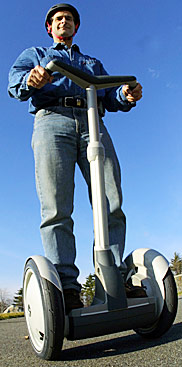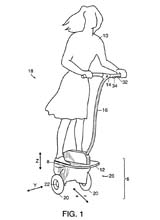AMY HARMON . NY Times . 03 december 2001
 Dean Kamen, an award-winning inventor in Manchester, N.H., rides the Segway Human Transporter, a two-wheeled battery-powered device. A finely tuned gyroscopic balancing mechanism intuits where its rider wants to go. |
 A patent application drawing for "Ginger" or "IT." |
It is not a hovercraft, a helicopter backpack or a teleportation pod.
The mystery transportation device being developed by the award-winning inventor Dean Kamen — the subject of continuous fevered speculation since provocative clues and predictions surfaced in media reports last January — is not hydrogen- powered, a favored theory in Internet discussions. Nor does it run on a superefficient Stirling engine (yet).
But if the public's collective yearning for Jetsonian travel technology must remain unrequited this week, at least the speculators will have their curiosity satisfied.
Mr. Kamen plans to demonstrate today a two-wheeled battery-powered device designed for a single standing rider. Its chief novelty lies in the uncanny effect, produced by a finely tuned gyroscopic balancing mechanism, of intuiting where its rider wants to go — and going there.
The device, the Segway Human Transporter, better known by its former code- name, Ginger, can go up to 12 miles an hour and has no brakes. Its speed and direction are controlled solely by the rider's shifting weight and a manual turning mechanism on one of the handlebars.
"You might ask, `How does it work?' " said Mr. Kamen, mounting one of the devices last week on a test track at his company's headquarters in Manchester, N.H. "Think forward," he said, inclining his head ever so slightly and zooming toward a reporter. "Think back," he continued, effortlessly reversing course.
Tilt sensors monitor the rider's center of gravity more than 100 times a second, signaling to the electric motor and wheels which way to turn and how fast.
Mr. Kamen says the much anticipated unveiling comes now because he has had time to file for crucial patents on the technology and is ready to test it publicly.
The United States Postal Service, the National Park Service and the City of Atlanta plan to begin limited field tests of the devices early next year. Amazon.com (news/quote) and several companies that make parts for the Segway, including GE Plastics and Michelin North America, plan to use the devices to try to save money by reducing the time it takes employees to move around corporate campuses and large warehouses.
At an average speed of 8 miles an hour, or three times walking pace, Mr. Kamen says the Segway can go 15 miles on a six- hour charge, for less than a dime's worth of electricity from a standard wall socket.
It is easy to see how the transporter tickled technology industry luminaries like Steve Jobs, founder of Apple Computer (news/quote), and Jeff Bezos, chairman of Amazon.com, when Mr. Kamen showed them an early model of the Segway. John Doerr, a partner in the Silicon Valley venture capital firm Kleiner Perkins Caufield & Byers, has invested $38 million in Mr. Kamen's efforts, the largest single investment in the firm's history.
The names and positive pronouncements of all three — Mr. Jobs reportedly said the device could be as significant as the development of the personal computer — were invoked in a supposedly secret proposal for a book to be written by Mr. Kamen and Steve Kemper, a journalist. But excerpts of the proposal, which won a $250,000 contract from Harvard Business School Press, were reported in January by Inside .com, which is now defunct.
The leaked proposal, which referred to the Segway cryptically as "It," set off a tidal wave of conjecture that led to several hundred media reports, tens of thousands of Internet postings and the question in the minds of some observers as to whether Mr. Kamen had set out a deliberate strategy to whip up public interest in his creation.
Mr. Kamen says he was mortified by the leak and that his reason for maintaining his silence in the face of so much speculation was to protect his company's intellectual property as it filed hundreds of patent claims. He suggests the level of interest is a sign of the actual hunger for a transportation choice that fills the niche between walking and driving.
The recipient last year of the National Medal of Technology, awarded by President Bill Clinton, Mr. Kamen, 49, has made millions of dollars creating medical devices including the first insulin pump and the first portable kidney dialysis machine.
Typically, Mr. Kamen sticks to research and development with his company, DEKA Research and Development, and licenses his inventions for others to market. But for the Segway, which grew out of his work on a motorized wheelchair that can climb stairs (code-named Fred), Mr. Kamen decided in early 2000 to form his own company to produce and market it.
A college dropout, Mr. Kamen has collected a total of about $90 million for the start-up, Segway, with Credit Suisse First Boston Private Equity and Kleiner Perkins as the lead investors. He retains majority control of the company, whose headquarters are in a complex of former mills about 10 minutes from his hexagonal-shaped home, which has a machine shop in the basement and two helicopters in the garage.
The decision to start the company was based largely on his personal attachment to the idea, Mr. Kamen said. Not one to shrink from sweeping statements, he argues that the Segway could cause cities to be redesigned, help wean the world from oil dependence, compress time and space for pedestrians and raise productivity for corporations and government agencies.
"Nothing has happened at the level of the pedestrian to improve transportation since we invented the sneaker," Mr. Kamen said. "We think if you could integrate the Segway technology into cities it would be a universal win for everybody."
That is a big if. The Segway is meant to be ridden on sidewalks, and many municipalities ban motorized devices on sidewalks. The machines weigh 65 pounds, and although they may be able to zip in and out of elevators and offices, going up and down stairs is a different matter. The device can be put in "follow mode," which helps propel it up and down, but there is still lifting to be done. Each one comes with a computer encoded on-off key protected by 64- bit software encryption to deter thieves or joyriders. But locking the machine to a parking meter or lamppost is far more awkward than doing the same with a bicycle.
Then there is the price. When the first models are expected to be available to consumers in about a year, they will cost about $3,000.
"I don't want to sound like a Ginger-slammer," said Paul Saffo, director of the Institute for the Future in Menlo Park, Calif., "but it's about $2,000 too expensive and 40 pounds too heavy."
Even if some consumers are taken with the devices, skeptics say the social resistance to them may pose an even greater problem.
"The big question is: Will pedestrians consider them socially acceptable on the sidewalk?" said Sheila Lynch, executive director of the Northeast Advanced Vehicle Consortium, a nonprofit organization that sponsors alternative transportation projects. "I've seen a lot of promising transportation innovations, and a lot of them aren't around anymore. I thought electric bikes would be a no- brainer, and they're not doing so well."
Even though scooters are much cheaper and faster, Mr. Kamen says that the Segway, which riders stand on facing forward, feet side by side, will have much broader appeal than scooters, which require an ability to balance and brave street traffic.
But Gary Bridge, Segway's senior vice president for marketing, is acutely aware of the need to develop a code of "Segway etiquette" before introducing the device to consumers. When Mr. Kamen invited a reporter to play on the Segway, Mr. Bridge reminded him, "We don't play, we ride."
"The last thing we want is to be seen as the snowboard," Mr. Bridge added.
To avoid such associations, the first field tests of the devices are set to take place over the next few months with government agencies and corporations. The United States Postal Service, for instance, plans to try 20 units on mail routes in Concorde, N.H., and Fort Myers, Fla., starting in January. The agency hopes the devices can reduce reliance on trucks and enable mail carriers to cover more ground.
And the City of Atlanta plans to use several dozen starting in February in an effort to reduce emissions and traffic congestion in its downtown area, where many employees drive three or four miles to work.
"The idea of being able to extend somebody's willingness to be on foot from a couple of blocks to four miles makes a lot of sense for us," said Michael Dobbins, commissioner of planning development and neighborhood conservation for the City of Atlanta, who wrote Mr. Kamen a letter after reading a newspaper article about "It" earlier this year.
Ultimately, Mr. Dobbins said, other commuters may want to use the device in conjunction with public transportation.
As for whether the Segway can ever hope to live up to the hype of Ginger and It, innovation experts say it is too soon to tell.
"This seems like a machine that wants to serve humans, and maybe that's his real breakthrough," said Arthur Molella, director of the Lemelson Center for the Study of Invention and Innovation. "But in terms of a conceptual breakthrough, we're going to see it as a breakthrough only if a whole lot of people use it."